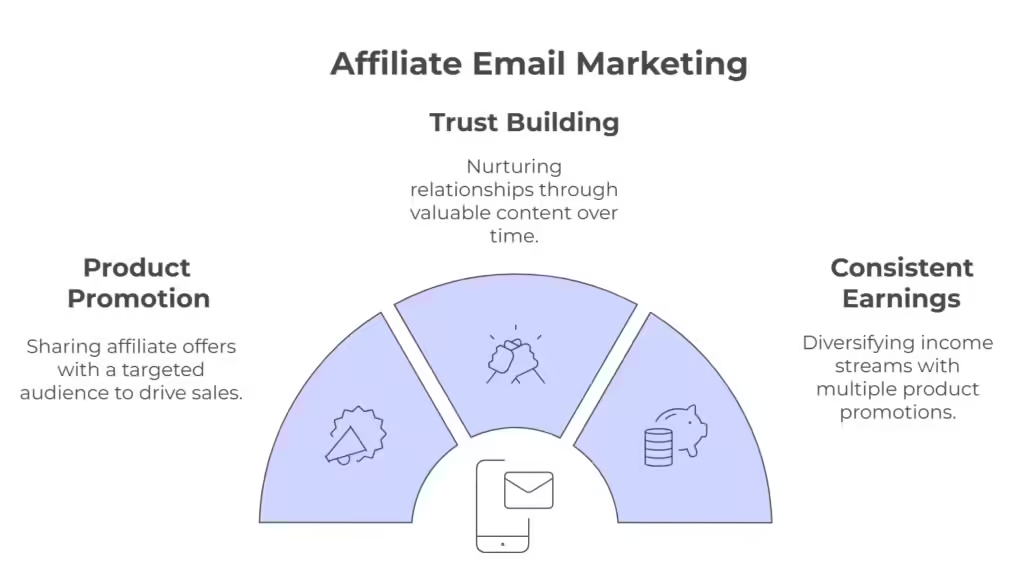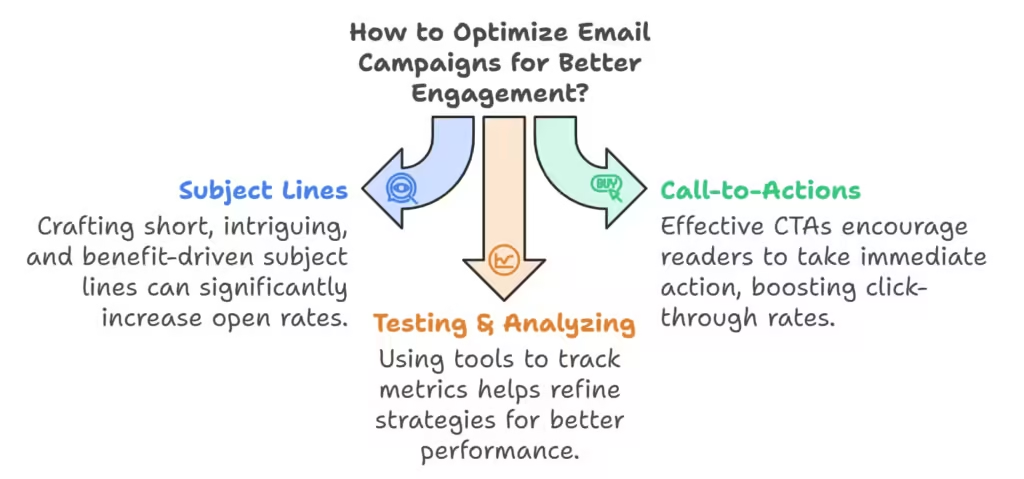If you’re eager to learn how to craft a high-performing affiliate email marketing campaign or uncover the smartest spots to embed your affiliate links, you’re in the right place!
We’ll guide you step by step through everything you need to know, plus sprinkle in some bonus tips to boost your affiliate success.
So, without further delay, let’s dive in!
Table of Contents
What is Affiliate Email Marketing?
Affiliate email marketing is all about promoting affiliate links through an email.
The difference here is that instead of just trying to sell something, the goal is to share how a product or service can actually help your audience.
These emails are crafted to catch your subscribers’ attention, increase clicks, and bring more traffic to your site.
For affiliate marketers, this is a goldmine. Your email list allows you to:

- Promote Products Directly: Share affiliate offers with a targeted audience.
- Build Trust Over Time: Nurture relationships through valuable content.
- Earn Consistently: Diversify your income streams with multiple product promotions.
But wait, what else can affiliate email marketing do for you? Let’s find out!
Step 1: Build Your Email List
Before you can gather the rewards of email marketing, you need an email list. Here’s how to start:
- Create a Lead Magnet: Offer something valuable for free, like an eBook, checklist, or guide, in exchange for email sign-ups.
- Set Up a Signup Form: Make it easy for visitors to subscribe by placing forms on your website, blog, or landing pages.
- Drive Traffic to Your Form: Use social media, ads, or blog posts to encourage sign-ups.
Step 2: Craft Winning Email Campaigns
Once you’ve built your list, it’s time to connect with your subscribers and keep them engaged. Here’s how:
Welcome Email:
- Start by saying hello and thank them for signing up.
- Introduce yourself briefly and remind them why they subscribed.
- Deliver the lead magnet (like a free guide or checklist) you promised when they signed up.
- Keep it friendly, short, and genuine.

Example:
“Hey there! Thanks for joining us! Here’s your free guide to [solve their problem]. I’m [your name], and I’m here to help you [goal]. Keep an eye on your inbox for more tips and tricks!”
Value-Driven Emails:
- Focus on helping your audience, not selling to them.
- Share tips, how-to guides, or personal stories that relate to their struggles or goals.
- Provide real solutions or ideas they can use right away.
Example Topics:
- “5 Quick Fixes for [their problem]”
- “How I Solved [their struggle] with This Simple Trick”
These emails build trust and make your audience see you as a go-to resource.
Promotional Emails:
- When it’s time to introduce an affiliate product, do it naturally.
- Start by talking about a problem your audience might have, then explain how the product helped you (or others).
- Be honest and only promote products you believe in.
- Include a clear call-to-action, like “Click here to learn more” or “Get yours now!”
Example Format:
- Problem: “Struggling with [issue]?”
- Solution: “This [product] changed the game for me. Here’s how…”
- CTA: “Check it out here!”
Pro Tip: Always stick to the 80/20 rule—80% value, 20% promotions.
Step 3: Build Relationships Through Consistent Emails
Consistency is key. Your audience should hear from you regularly, but not so often that they feel overwhelmed.
- Frequency: Aim for 1–2 emails per week. Pick a schedule you can stick to.
- Tone: Write like you’re talking to a friend. Avoid being pushy or salesy.
- Ask Questions: Include questions to encourage replies, like “What’s your biggest challenge with [topic]?”
- Engagement: Always respond to your subscribers who reply. It builds trust and makes them feel valued.
Consistency keeps your name fresh in their minds and builds a strong connection over time.
Step 4: Optimize for Better Results
Improving your email performance isn’t hard—you just need to pay attention to what’s working and what isn’t. Here’s how:

- Subject Lines Matter:
- Keep them short and to the point.
- Use curiosity or urgency to grab attention.
- Examples: “Don’t Miss This [Solution]” or “Are You Ready for [Benefit]?”
- Content Is Key:
- Write simple, clear, and easy-to-read emails.
- Add personal touches like using their first name (if your tool allows it).
- Break up long paragraphs with bullet points or subheadings.
- Track Your Performance:
- Use your email tool (like Mailchimp or ConvertKit) to check open rates, clicks, and replies.
- If an email has low engagement, try testing a new subject line or offer.
- Split Testing:
- Try sending two different versions of an email to see which one performs better.
- Change one thing at a time, like the subject line or call-to-action.
- Focus on the CTA:
- Keep your call-to-action simple and easy to follow.
- Examples: “Grab Your Copy Here” or “Start Today for Free!”
- Mobile-Friendly:
- Most people check emails on their phones, so make sure your design and links work well on mobile.
Pro Tip: Even small tweaks can lead to big improvements, so always look for ways to make your emails better!
5. Avoiding Spam Filters
To make sure your emails reach your subscribers and don’t end up in the spam folder, follow these simple strategies:
1. Use a Professional Email Address
Always use a professional email address tied to your domain (e.g., info@yourdomain.com) rather than free services like Gmail or Yahoo. This helps establish your legitimacy and reduces the chance of your emails being flagged as spam.
2. Avoid Spammy Words
Certain words like “FREE!!!” or “CLICK NOW” can trigger spam filters. Instead of using over-the-top language, try phrases like “Exclusive Offer” or “Limited-Time Deal” to sound more natural and relevant.
3. Include an Unsubscribe Link
Always add a clear and easy-to-find unsubscribe link in your emails. This gives your subscribers an easy way to opt out and helps prevent them from marking your emails as spam.
4. Send Only to Opted-In Subscribers
Only send emails to people who have explicitly signed up to receive them. This helps build trust, ensures you’re following the law, and reduces the risk of your emails being flagged as spam.
By following these steps, you can improve your chances of landing in the inbox and build a stronger relationship with your audience.
The Benefits of Email Marketing for Affiliates
Creating an affiliate email marketing campaign comes with a whole array of benefits:

- It’s cost-effective.
- You can create highly-targeted personalized emails.
- You have a worldwide audience to market to.
- Performance tracking is easy and near-immediate.
- You can send timely campaigns with little effort.
- The affiliate industry is highly compliant with marketing laws.
- You have a forum to promote yourself.
- You can also increase your email list and conversion rate over time.
By following these steps and tips, you’re well on your way to mastering affiliate email marketing and seeing results like never before. Start building your email campaigns today and watch your affiliate success grow!